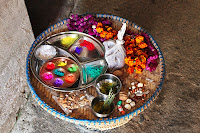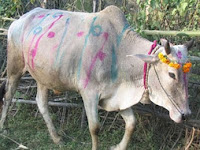💘TIHAR💘
Tihar is the second biggest Nepalese festival after Dashain. It is considered to be of great importance as it shows reverence to not just the humans and the gods, but also to the animals like crows, cows, and dogs that maintain an intimate relationship with humans. People make patterns on the floor of living rooms or courtyards using materials such as colored rice, dry flour, colored sand or flower petals outside of their house, called Rangoli, which is meant to be a sacred welcoming area for the Gods and Goddesses of Hinduism mainly Goddess Laxmi.
 On the first day of Tihar, crows are worshiped and fed early in the morning. People leave different food items outside for crows to eat. Crow is considered to be the messenger of death. People believe the crow gets the messages to the house in the morning. People worship it to bring good luck themselves. I also worshiped crow and gave some sweets and meat to it. I was an amazing experience for us.
On the first day of Tihar, crows are worshiped and fed early in the morning. People leave different food items outside for crows to eat. Crow is considered to be the messenger of death. People believe the crow gets the messages to the house in the morning. People worship it to bring good luck themselves. I also worshiped crow and gave some sweets and meat to it. I was an amazing experience for us. The second day of tihar is dedicated to the most loyal friend of mankind. Kukur, the dog, Puja is done by putting a red tika on dog’s forehead and flower garland around the neck offering him foods and sel roti. Since we dont own a pet dog, we worshiped a locally famous dog which has been named as "kalay". We have known this dog for more than 5 years. This maybe the reason why whenever we are around, he keeps on following us.
The second day of tihar is dedicated to the most loyal friend of mankind. Kukur, the dog, Puja is done by putting a red tika on dog’s forehead and flower garland around the neck offering him foods and sel roti. Since we dont own a pet dog, we worshiped a locally famous dog which has been named as "kalay". We have known this dog for more than 5 years. This maybe the reason why whenever we are around, he keeps on following us. On the third day of tihar Cows are worshiped in the morning. Cows are worshiped with sesame oil light, garland of flower and red color (abir). Wheat flour, sel roti, rice and dal are feed to cows. Disciples try to pass in-between four legs of the cow. Cow is regarded as mother in Hindu religion, as we grow up drinking her milk. Some look cow as Goddess Lakshmi, the goddess of wealth and prosperity.
On the third day of tihar Cows are worshiped in the morning. Cows are worshiped with sesame oil light, garland of flower and red color (abir). Wheat flour, sel roti, rice and dal are feed to cows. Disciples try to pass in-between four legs of the cow. Cow is regarded as mother in Hindu religion, as we grow up drinking her milk. Some look cow as Goddess Lakshmi, the goddess of wealth and prosperity.
In the afternoon we clean our houses, paint floors with Red Mud (Rato Mato) and cow dung (gobar). Small circle
are made in front of the main gate and decorated with colorful designs. Some people call it rangoli.
 On Govardhan puja Goru Tihar, three different Kinds of puja are performed. We perform Goru Puja, or worship Oxen. We also perform Govardhan Puja, which is done by making a hill of govardhan parbat using Cow dung. Cow dung has big importance in Hindu culture. In the old days it was used for everything from light at night (Methane) to polish mud floors of traditional houses. Still now no Puja is complete without cow dung in Nepali Hindu culture. Deusi is very similar to Bhailo. Bhailo is primarily for female and Deusi for male. However, now a days there is such distinction. People go in group with males and females members to celebrate Bhailo and deusi both.
On Govardhan puja Goru Tihar, three different Kinds of puja are performed. We perform Goru Puja, or worship Oxen. We also perform Govardhan Puja, which is done by making a hill of govardhan parbat using Cow dung. Cow dung has big importance in Hindu culture. In the old days it was used for everything from light at night (Methane) to polish mud floors of traditional houses. Still now no Puja is complete without cow dung in Nepali Hindu culture. Deusi is very similar to Bhailo. Bhailo is primarily for female and Deusi for male. However, now a days there is such distinction. People go in group with males and females members to celebrate Bhailo and deusi both. The fifth and last day of Tihar is Bhai Tika. This day sisters put “Tika of five colors” Pancha Rangi Tika - Yellow, green, red, blue and white on forehead of her brothers, to ensure long life and pray to Yamraja for her brother’s long life and prosperity. Sister offers brothers Shaguns of dry fruits especially walnut, hazelnut (Katus), fruits and sweets and in return the brothers give their sisters gifts and money. The brothers also put Pancha Rangi Tika to sister and bow her on her feet and assure her to protect her till the end of life.
The fifth and last day of Tihar is Bhai Tika. This day sisters put “Tika of five colors” Pancha Rangi Tika - Yellow, green, red, blue and white on forehead of her brothers, to ensure long life and pray to Yamraja for her brother’s long life and prosperity. Sister offers brothers Shaguns of dry fruits especially walnut, hazelnut (Katus), fruits and sweets and in return the brothers give their sisters gifts and money. The brothers also put Pancha Rangi Tika to sister and bow her on her feet and assure her to protect her till the end of life.
To conclude, it was one of the most amazing Tihar that I've experienced. With all of those colors and flowers, this tihar will always be there in my album of memories!!

Comments
Post a Comment